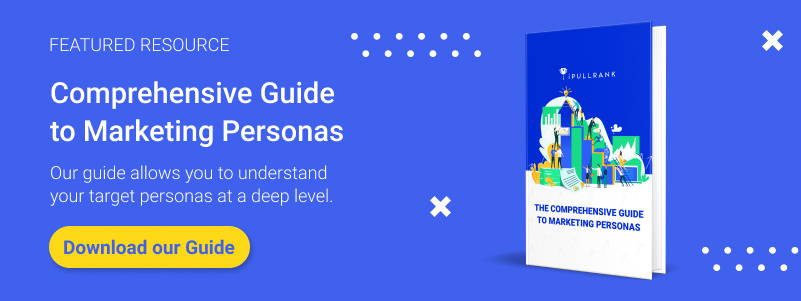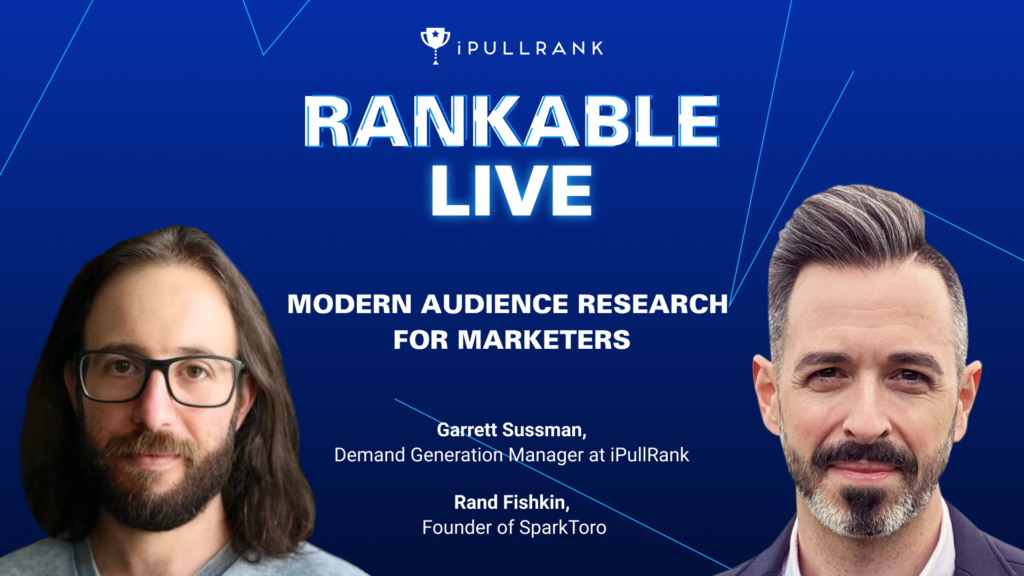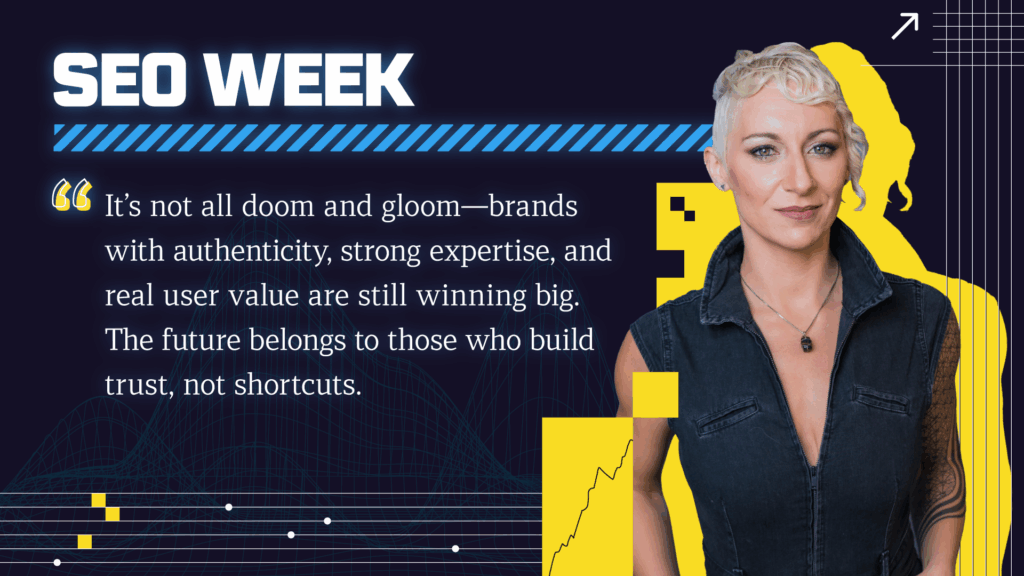Welcome to Episode 61 of iPullRank’s Rankable Podcast, where we discuss various hot topics in the world of SEO and digital marketing.
On Ep. 61 of iPullRank‘s Rankable Podcast, Garrett Sussman hosts Rand Fishkin, CEO and co-founder of audience research software SparkToro to discuss the topic “Modern Audience Research for Marketers”
SparkToro was not Rand’s first SaaS rodeo though. He started the SEO software company Moz and wrote the book on his experience, Lost and Founder.
He’s an educator of SEO, a nurturer of entrepreneurs, and an advocate for social action.
Published on many industry websites, Rand will address the challenges that many marketers face in discovering their audience and what makes them tick.
We also discussed:
- How does market research pertain to the size of your business?
- What are the primary goals of market research?
- How do you shadow and interview online dark communities to surface market insights?
- How should market research influence your marketing strategy?
- Unique audience research challenges for enterprises
Transcript:
Garrett Sussman: Hey everybody, what is up? We are here. My name’s Garrett Sussman from iPullRank for Rankable Live. It’s our podcast. I’m excited. I got this dude who, who dresses well and eats good. His name is Rand Fishkin. He is the co-founder and CEO of SparkToro, which is this really bad-ass cool market research software.
Well, we’re going to dive into everything audience research and what the tool does, but also just kind of Rand’s perspective on it. Thank you so much for joining me today, Rand.
[00:00:39] Rand Fishkin: Yeah. Thrilled to be here, Garrett. Thanks for having me.
[00:00:41] Garrett Sussman: Awesome. You’ve done some other stuff. You were the founder of Moz.
[00:00:45] You wrote a book, but today I really want to talk to you about men’s fashion.
[00:00:50] Rand Fishkin: All right.
[00:00:50] Garrett Sussman: Now you told me before, you’re talking about how one of your personal interests is men’s fashion. Although you’ve got beef with the fact that guys don’t really shop together.
[00:01:03] Rand Fishkin: It’s a sad thing to me.
[00:01:05] I found that one of my love languages, apparently is taking my guy friends out and buying some fun clothes together. I think this is a thing, and I think we all agree, many adult women bond over this experience. And I think men should get to do it too. It’s kind of fun.
[00:01:28] It’s a great way to spend a little bit of time together and chat about whatever’s on your mind and have a sort of active walking experiential thing going on. That’s fun, you know?
Yeah. I especially like doing it not in the United States. I find that the US yeah, US men’s clothing, it’s just, the US is dominated by chains because we sort of has this weird economic system that prioritizes a few people at the top.
[00:02:00] But if you go to Europe or South America or Japan or something, you can have a lot more fun doing it.
[00:02:10] Garrett Sussman: Well, I mean, you obviously seem like a classy guy. You appreciate fashion, but it’s funny, I was reading an article the other day. How malls are not a thing anymore. I bet you have some strong opinions about malls and mall culture.
[00:02:24] Rand Fishkin: Ooh, I don’t know. I don’t like to yuck anybody else’s yum. So if you love malls and you miss them and you think they were the best thing ever. Great. I’m sad. I think there are a few malls that still exist and hopefully, you can go to them and have fun. I never had a particularly strong attachment to malls myself.
[00:02:45] My parents would take us to the mall that was closest to our house, which was still like an hour away growing up. Cause we were in a very rural part of King County, Seattle area and I didn’t totally love it. I don’t know.
[00:03:03] Garrett Sussman: I know you don’t yuck yums, but I think it’s culturally, it’s just fascinating that they built these kinds of economic centers.
[00:03:12] I know personally, I had a bad association with malls because I never wanted to be there with my mother because I had a very opinionated, strong Jewish mother who was like, oh, you know, let’s go to the Gap and you’ll look great in these clothes. And that was my worst nightmare.
[00:03:30] Rand Fishkin: Yeah, I think of the mall as a bonding experience for teenagers and kids and people who got together there with their friends, I think that was a very different experience than those of us who went exclusively with family to go shopping. Like that was another layer on top of that.
[00:03:51] I would say what I don’t love about malls in general as I’m quite passionate about underdogs over kind of big players in any space and mall culture. And the concept of the mall in the United States is very much around. You can go to any mall and find the same 25 chains. So it homogenized the United States.
[00:04:20] It built this culture of sameness, which I also don’t love. I’m someone who loves diversity in all things. I love it in fashion. I love it in food. I love it in travel. I love it in people. I love it in company culture. And so the homogenization and sameness really turned me off. I don’t think I could’ve framed why that was as a kid.
[00:04:47] Certainly that’s not something that appeals to me now. I love going to other countries and experiencing this idea that every block, every strip mall, in Italy or Germany is different because it’s all different businesses. It’s not the same companies operating the same things. You find brands you’ll never see anywhere else.
[00:05:12] I’d never heard of the company that makes this sweater before and walked into a shop in Brescia, which is in Northern Italy, and was like, that’s beautiful. I’m going to get that. And I don’t know, it’s like 60 bucks. Can’t be beat.
[00:05:27] Garrett Sussman: Wow. I’m with you on that because I’m similar in the respect that, I think there’s something special about a unique experience about having something that nobody else out there can really experience the same way.
[00:05:42] That’s what I love about music right now. Sometimes I feel overwhelmed with Spotify, but I love discovering bands that no one’s ever heard of. And I’m like, they’re my band. That’s my music.
[00:05:53] Rand Fishkin: I think this is a beautiful thing in just all aspects of life, right? The uniqueness.
[00:05:58] I think this is one of the tragedies of capitalism’s evolution is that it rewards big brands, big companies, scale, ability to dominate through monopoly, power and pricing power and economic levers. And what I love about capitalism, Right? And what I think the initial promise of a liberal capitalist society is that lots and lots of people can do what they want to do.
[00:06:34] If you want to specialize in making soft men’s sweaters in Northern Italy, and that’s your thing, great, you go do it. And if you want to make chemical processes for refining cardboard. Awesome. That’s open to you and if you want whatever weird, unique thing you want to do, it’s possible as long as there’s market demand for you to invest in that. I think that’s a beautiful principle.
[00:07:05] And what I dislike about capitalism, especially the last 50 years of it, has been this like concentration of wealth and power sameness. Monopoly power is something I hope that maybe politically at a bigger scale and personally at a smaller scale, we can make a difference and start to change that conundrum situation.
[00:07:33] Garrett Sussman: The thing is, I think it actually segues perfectly into a conversation around SparkToro, because there is in the same context for each of these individual unique brands, so much content out there. Right? And you are a big advocate around this idea of the amplifier who actually has built community and there are podcasts. There are blogs. There are video shows out there. So translate that kind of unique experience to what the modern marketers should think about when they’re trying to find their audience.
[00:08:13] Rand Fishkin: Yeah. So there’s this world of sources of influence, right? Uh, communities, content creators, publications, people that groups of people pay attention to is one in which that kind of classic model of high variability, incredible uniqueness is still true.
[00:08:35] Right? It’s much more long tail than it is the sort of fat head, monopoly owned and controlled, unlike 50 years ago, when most Americans read maybe two or three local newspaper publications and maybe the New York Times, the Washington Post, and maybe they watch CBS News.
[00:08:59] Now there are 10,000 sources, that people have listened to over the course of a few years. And I think that’s actually kind of exciting. I love that diversity of content of influential people in publications. The challenge as a marketer is that we don’t get to be Don Draper, Mad Men era. Like, okay, “How do I make an advertisement and put it on one of the five channels that I know my audience pays attention to because every audience pays attention to those channels?” Our challenge today is different. We have two choices, essentially, right? We can take all our dollars and currency and whatever it is, Garrett.
[00:09:42] Right? And we can throw it at Google and Facebook and tell them to sort out the target. That’s option A.
[00:09:49] Garrett Sussman: And trust them to do it…
[00:09:51] Rand Fishkin: Always a good idea to trust Google and Facebook. They’ve never let us down before. No. And B. Option B. Instead you go and find the sources of influence that reach your specific audience and the audiences that you’re trying to get to pay attention to your content or your product or the problem you’re trying to solve, or whatever it is. The movement that you’re trying to create and you go market to them through all of those communities and sources of influence in ways that are going to resonate.
[00:10:25] I think that most marketers will agree that while option B is more difficult, it tends to have higher ROI, but it’s more challenging to measure. And it’s more challenging to get clients and teams to invest in because Google and Facebook have, of course, locked people into this idea that their marketing should be measurable, especially digital marketing.
[00:10:45] And unfortunately, you’ve got to take a more challenging, more nuanced view of measurability when you expand outside of those two. So this is something that obviously I want to help people with that SparkToro tries to help people with, but it’s an uphill. Yeah.
[00:11:07] Garrett Sussman: And it’s one thing that’s really interesting to me.
[00:11:09] So a lot of our audience, and we’ll get to the enterprise aspect of audience research, but you have these different sized businesses and they all want a piece of the pie. How do you scale? When you’re doing your marketing research and you’re trying to identify your sources of influence, how do you decide the size of the amplifier to go after?
[00:11:31] If you’re a small, little mom and pop. I mean, sure, it’d be great to get on like a CBS national show, but…
[00:11:39] Rand Fishkin: Maybe?
[00:11:41] Garrett Sussman: Maybe? I know I saw you did a video about TikTok and just getting out there and being like, that’s not where our audience is. How do you decide who to go after in the first place to pay on your business side?
[00:11:52] Does it matter?
[00:11:53] Rand Fishkin: Yeah. So I think about this from the perspective of; I guess it’s really three things. It’s number one, does this source of influence reach a significant percentage of people who are likely to care about what I’m doing, what I’m messaging to them, what I’m telling them, right? If whatever it is, if it’s CBS News or if it’s the Wall Street Journal or something.
[00:12:21] Right? And I pitched the Wall Street Journal about, “Hey, you should write about SparkToro and how we do audience research.” They might cover us. Right? I’m lucky enough to have a bunch of contacts to the Wall Street Journal. They’ve written about Lost and Founder before and some of my work with the Google zero-click problem.
[00:12:39] So let’s say I did manage to get a piece into the Wall Street Journal that was about audience research and features SparkToro, and maybe talked about the sector and this upcoming idea of doing market research through passive social and web research. That could be cool. It might be something to point to.
[00:12:55] I could show my grandfather and be like, Papa, look, we were in the Wall Street Journal. Is it going to reach a high percentage or even a tiny percent of marketers in the digital field who are likely to be good customers for SparkToro? No, I don’t think so. Right? I mean, I’m not blowing smoke here, it’s probably more valuable for me to be on this podcast.
[00:13:23] Garrett Sussman: Oh, well Rand, no, but it’s precision.
[00:13:28] Rand Fishkin: Precision.
[00:13:29] It is targeting exactly the audience that you want to reach with the right message at the right time, in the right way through the source of influence that they actually pay attention to. And not just going after vanity metrics.
[00:13:41] Like, well, this is a brand name that people have heard of, and this is a publication that is national. Well, lots of people read the Wall Street Journal and it would be expensive to buy advertising there. That’s not what an entrepreneur should care about. Right? Right. Now, look, I’m not telling you that if you’re doing PR, your clients don’t ask you to get in the Wall Street Journal.
[00:14:04] They do, and they’ll probably reward you for that. But the business result, the outcome of the number of people who are likely to be good customers for your product, that is much smaller. So that’s the first thing that I think about is precision targeting.
[00:14:23] Garrett Sussman: Keep going.
[00:14:25] Rand Fishkin: No, I was going to say the second thing for me is really, do I have a shot?
[00:14:29] Hmm. Right. Is it, is it possible? Do I have some pitch that is likely to be successful? That’s going to get me onto that podcast featured on that person’s YouTube channel talked about by that publication sent out in that email newsletter featured on that blog, whatever it is? And then the third one for me is about the message itself.
[00:14:52] I would say it’s the combination of this person’s publication and the message that I’m talking about. Make sense together in a natural fit kind of way, because I think when it’s unnatural, it’s very easy to tell, right? So if you, if Garrett, you invited me on here and we spent the whole time talking about, I don’t know, men’s fashion and I promoted some online men’s clothing store. It’s awkward. Right? It doesn’t quite make sense. Rankable is not really about that. And sure, we tease the topic of men’s fashion and it’s fun and engaging and sort of funny. It has some of those hook aspects, but it’s not what we, what our audience expects us to talk about.
[00:15:42] And so the fit is awkward, even if the other two things might be working. So those are the three that matter to me. That’s what I’m looking for. That’s what I think a lot of marketers want to be looking for whether their clients or their teams and their CMOs are always buying in.
[00:16:01] Garrett Sussman: Right? No, I agree. I mean, that’s the whole thing.
[00:16:04] I feel like market research, in general, goes through this kind of fluctuation of value in different organizations and you even say it right on the homepage of SparkToro, “SparkToro is trying to give tools that the big guys, big girls, whoever uses that we’re not used to using.”
[00:16:23] So you do think that market research is important. When does that get started? If someone’s never done research or really thought about it, how do you start with it? Or how do you restart with it?
[00:16:38] Rand Fishkin: Yeah. I need to publish a blog post about this. I’ve been meaning to for a long time.
[00:16:43] So there’s this concept in behavioral psychology. Called an influence map. And essentially, behavioral psychologists will take a particular field. And they’ll say, for example, what is the influence map of how people think about vaccine information and preventing the spread of disease and whether they should get an MMR shot for their kids and whether they should get a COVID vaccine and get their booster shot and all this kind of stuff.
[00:17:14] And of course, this is a big public health impact. Right? And you have the potential to kill millions of people or save millions of lives. Very, very impactful kind of thing. Right. And so behavioral psychologists will build an influence map. People listen to these health resources and they visit these websites and they search on Google and they watch these YouTube channels.
[00:17:37] And these are all things that impact them. Garrett. I’m going to do a thing. There’s a leaf blowing gentlemen outside of my office. So I’m going to switch to some headphones. Let me just start. Okay.
[00:17:49] Garrett Sussman: No, it’s interesting when you talk about that too, cause the first thing that comes to mind specifically with COVID was how during….
You know, at one point they had, I forget who it was that came on, maybe Arianna Grande or Olivia someone, they brought someone up on one of the press conferences. And obviously, they’re trying to get this message out to a different type of audience, I’m thinking to myself.
[00:18:16] It goes back to your, your weird, awkward fit. But at least they were trying to influence the people that they thought their target audience would be interested by.
[00:18:27] Rand Fishkin: Right. So you’re right. And this concept of an influence map is essentially where you attempt to theorize and visualize and experiment with where you believe your audience pays attention and the sources that influence them.
[00:18:45] And that can be a lot of things, right? It can be that they go to their doctor’s office. This is one of the reasons I think that Spain, for example, had so much success in getting people vaccinated, right? Because there’s an extremely high amount of trust between family doctors and individual patients.
[00:19:05] Their healthcare system kind of prioritizes this. As we would imagine in the United States, like a very classic Americana, old school, you go see your family physician. And that person is someone, you ike, and trust and have known for decades. And so when they tell you, “Hey, you should get a vaccine shot. Hey, you should get a second shot. Hey, you should get a booster shot.” People just listen. Right. And so, they got up to whatever they’re at 88, 90% vaccination rates and as a result, had a lot of success with the disease, right? And you can do this for anything.
[00:19:43] You can say essentially, “Hey, I want to influence folks in the chemical engineering world to be aware of a new process for reducing the environmental impact of plastics production.” And in order to do that, it’s these conferences that are very impactful.
[00:20:04] It’s this chemical engineering trade organization. I think it’s like KCH2M or something that’s very well known in the field and nearly every chemical engineer follows it and pastes it into, right. So if you can get them to talk about this process and promote it. That’s a great place. Oh, and there’s a lot of the field managers impact a bunch of the linework that chemical engineers are doing at the drafting tables and boards. Okay. Now we have our influence map of where we think this audience receives information, how they process it, how they determine what’s trustworthy.
[00:20:48] Let’s go experiment with marketing through these places where, where we think we can do the three things, reach the right audience with the right message and actually get our pitch accepted.
[00:21:00] Garrett Sussman: Yeah, no, it makes sense. Especially cause you have limited time, you have limited resources, no matter how big an organization you are.
[00:21:09] There are always limitations on how much budget you can spend, how much time you can spend. One thing I want to ask before we actually pivot over to entrepreneur or on to enterprises because I’m just curious in this direction that we’re going. I know you recently tweeted about crypto and there’s a lot of talk about web3 and community, though. And dark social and the dark web. I’m curious too, like how bullish you are on those in terms of the idea of audience research and putting the message in those types of places where as a marketer, you might have less control, but there are really important conversations happening, like in these built communities?
[00:21:51] Rand Fishkin: Sure. So if you imagine, “Oh, there’s a private Discord or a lot of this is happening in private backchannels on WhatsApp or, it’s messages between people in the old school world. Oh, it is people on bulletin board systems in 1991. Right? That kind of stuff. Completely unobservable.
[00:22:16] And in those cases, I think the reality is that the marketer’s job is to pay attention to communities like that to interview and talk to, and have relationships with people who are using those channels but not to be going privately into those things and posing as someone who fits in the community and then trying to promote the product. That stuff never works.
[00:22:44] What does work really well is having those conversations and from those conversations being informed about why people talk positively about your product service solution, bring up your problem, how they frame it, what kinds of conversations happen that make them have those private chats around it, and then talking to your product team.
[00:23:13] A lot of the times, having the product bake in some of the marketing lessons you’ve learned from the audience.
[00:23:23] Garrett Sussman: I love that. It makes sense, like tapping into the insight without being inauthentic, right? Like forcing yourself into someone else’s ecosystem and disrupting them.
[00:23:33] Rand Fishkin: Yeah. I mean, when you talk about these private conversations. Web3 is a little funny.
[00:23:43] Garrett Sussman: Cause even Reddit feels like that sometimes.
[00:23:46] Rand Fishkin: So Reddit is a very public place, right? Where you can do a lot more of the active kinds of marketing if you want to. But it’s also a place where I would advise, generally speaking, you want to go more, hands-off, more listen and change kind of product and marketing and positioning and conversation direction and other places rather than jumping in and being like, that’s not true.
[00:24:09] We deliver a high degree of quality in our product. Don’t do that right. So my thinking along that front is you don’t directly participate. You learn and then you change your product, positioning, content messaging in other places, right on your website. When you talk publicly about it, perhaps in the very product itself, you’re making changes, that’s kind of how you do marketing that reaches those one-to-one stores.
[00:24:45] Garrett Sussman: I love that. And that’s a whole other, I mean, with you when you’re talking to you. We could go down so many different rabbit holes. It’s always tempting, but I do want to bring it back to the idea of the enterprise, which I think is a different type of animal when it comes to market research.
[00:25:01] They do have the tools, but marketing is changing. I’m curious how you look at, like, if you were working in an enterprise doing market research, how that’s different from a mom and pop or even just any small business.
[00:25:19] Rand Fishkin: Sure. So the reality with enterprises, especially when it comes to marketing through individual sources of influence, especially smaller channels, a podcast, a YouTube channel, a publication, an email newsletter, a conference, whatever it is, unless it’s enterprise B2B, meaning very small number of clients that they’re trying to reach, hundreds or thousands. Right. The reality is that these channels are not going to be needle-moving for them.
[00:25:54] If you are Proctor and Gamble, getting on a podcast to promote Colgate, it’s not that it’s impossible, but it’s not. If you’re Tom’s of Maine toothpaste, especially maybe 15 years ago when they were starting up. Yeah. Podcast marketing was probably pretty darn smart. Right.
[00:26:19] Made a lot of sense. You’re a challenger brand. You’re a startup. You have a story to tell, you’re trying to get some of the early adopters to come on board with you. That makes sense. If you’re a dominant brand in a space, you’re your Coca-Cola. Yeah. You probably want to throw money at the Superbowl and Google and Facebook.
[00:26:37] Garrett Sussman: I was going to say at that point, is it all about creative and messaging? Is it all about brand when you’re at the enterprise level, in terms of market research?
[00:26:46] Rand Fishkin: No, not entirely. Great example was that there was this viral story that I think the Washington Post wrote about where Chase bank right had been running ads on 400,000 websites through, I think the Google display network. And they cut that down. They basically axed everything except for I think, 4,000 websites. Right? So they cut it by 90%. And what happened? Same result. All right. Same number of conversions, same number of clicks, same amount of traffic, same brand efficacy, same ROI.
[00:27:23] So what’s going on there? Well, there’s a lot of shit in the ad network world. Right. And so when you were at the enterprise size, I think your job is not to just throw money at these big providers and let them sort out the targeting. You also need to do a lot of auditing. You’ve got to do a lot of manual investigation.
[00:27:46] You have to do experimentation. You’ve got to do incrementality testing. It’s a very different type of game. I wrote about this recently in the blog post. What if performance advertising is just an analytics scam and my contention there is I think a very high percentage of what Google and Facebook take credit for and other ad networks take credit for are conversions that would have happened anyway.
[00:28:13] And so if you’re at the enterprise size, you are probably getting a lot of misinformation about what’s yielding true incremental increase in your customer acquisition and sales and you should do some testing around that.
[00:28:33] Garrett Sussman: It is really interesting. I remember a similar article about Airbnb. They had a similar experience with advertising, but I think it’s interesting with attribution when you go there because attribution, the reality is it’s just hard, right? It’s just hard to do. And it takes a lot of sophisticated statistical analysis and analytics to be able to properly attribute whatever the touch rates are. I saw on Twitter recently there, that whole argument, you see that statistic floating around of, it takes seven brand touches before someone is willing to be a customer.
[00:29:08] And that is provenly outdated. It might not ever have actually been accurate.
[00:29:13] Rand Fishkin: That’s right.
[00:29:15] Garrett Sussman: So how do you approach that?
[00:29:17] Rand Fishkin: Yeah. I think you have two options, right? You can spend tens of millions of dollars in terms of people and technology and resources to attempt to get very close to real attribution, right.
[00:29:37] And real incrementality, but you will need an absolutely massive team, incredible budget, phenomenal technology. And even then, you’ll probably be inaccurate and every month you’ll be improving and you’ll realize 12 months into a $20 million budget. I talked to someone recently who is director of marketing for an e-commerce brand, a very big e-commerce brand.
[00:30:05] She was like, “Oh yeah, no, we’re investing, tens of millions of dollars in incrementality and attribution and trying to determine where we should really put this budget because it’s so meaningful to our investments long-term and our growth and all this kind of stuff. And she was like, “Every year we make so many improvements that we realize the model we had the previous year was completely wrong.
[00:30:31] Completely misleading and we learn a whole ton of new stuff.” Let me tell you, friends. I mean, if brands like this are doing it and finding that, and it was a very impressive person, right? So I’m just saying, I think you could throw a lot of resources at that and not solve the problem.
[00:30:55] And so it might not be the end of the world. It might not be the end of the world to do some gambling and some experimentation and some, “Hey, we’re going to act like marketers did from 1900 to 2005.” And basically, invest in channels and tactics that target the right kinds of people that appear to produce results for us.
[00:31:26] And we’re not going to worry about perfect attribution. You might save a hell of a lot of pain and energy and if you don’t worry so much about proving it to yourself…
[00:31:40] Garrett Sussman: It so much kicks yourself when you realize some of that stuff too. And it does work and, it’s funny.
[00:31:45] We could obviously keep going. We didn’t even get to the fact that we’re in a paradigm shift just between the pandemic and how people consume and buy. That might shift us completely with remote working and market research there. So we’ll have to have you on for another podcast at some point, but I do want to ask you before we go, and I realize this potentially could get political, but feel free is we talked about Facebook and Google advertising and that being something that people are just wasting their money on.
[00:32:18] Do you think that’s going to change? Like if you looked into your crystal ball, do you think, what would it take for us to get to a point where the whole advertising marketing world isn’t so dependent on these two ad behemoths?
[00:32:32] Rand Fishkin: In the short-term, I think the only likely thing that would change that is significant antitrust activity.
[00:32:45] And that’s possible, right? One of the rare things that both political parties in the United States generally agree on is that they don’t like the power held by Google and Facebook and they want to make some significant investments there. I think that the Trump administration obviously started a bunch of investigations and they kind of petered out because they tried to wrap it all up before the election, whatever.
[00:33:13] But the Biden administration is doing the same thing. Congress is doing the same thing. A bunch of state attorneys generals are doing the same thing. Yeah. Probably we’ll see some action and whatever that action is, we’ll have, that’ll determine whether there’s real impact and real change in terms of the marketplace.
[00:33:32] Right. But like in my dream scenario, I imagine that Facebook, Instagram, and WhatsApp are three different companies. I imagine that Google, YouTube, and Google Maps are three different companies. And then I think you create a ton more opportunity for innovation and incentive for innovation and competition, which leads to more new companies and more diversity of channels and more diversity of opportunities and probably a lot more good things in that space.
[00:34:04] I know there are skeptics who are like, no breakups, never work. I fundamentally disagree. I think history disagrees. When I look at the Microsoft anti-trust action from the nineties, which wasn’t even a breakup, right? It was just a restriction on what Microsoft could and couldn’t do. I think that paved the way for an open internet.
[00:34:24] I think otherwise we’d be living in an era where Microsoft owned. Search, Social, Video, everything. Right? You couldn’t use a Google Chrome browser on your Windows desktop.
[00:34:36] Garrett Sussman: I’m going to say Google’s not actually good at social and Google’s not actually good at e-commerce, you know, like otherwise, Amazon and Facebook and all those probably wouldn’t be… Google Plus.
[00:34:48] Rand Fishkin: Yeah. Yeah. So I think that’s in the short term. The only real thing I don’t see individual advertisers being like, I’m going to reject Google and Facebook. It’s just not that, that, that doesn’t make a difference. Right?
[00:35:05] Garrett Sussman: If Cambridge Analytica didn’t divert enough people from buying Facebook ads, then that’s not going to happen.
[00:35:11] Yeah. I’m with you. Rand, thank you so much. As I said, I could talk to you forever about this stuff. It is always a pleasure. What are you cooking? What are you cooking for the holidays before we go?
[00:35:24] Rand Fishkin: So my wife and I are going down to San Diego where her family is.
[00:35:29] So we will not be cooking for a few days. But, when we get back…
[00:35:37] Garrett Sussman: Is that going to be difficult for you?
[00:35:39] Rand Fishkin: Yeah, we’ll put on masks and we’re getting our booster shots on Saturday. So we’ll try and be as safe as we can possibly be. And the nice thing about Southern California, even in November, you can dine outside, so we will be.
[00:35:56] Yeah, very safe. And then, when we come back, I think we’re going to try and do a little Friendsgiving thing for some people close to us in our world. And I think I am making the cranberry sauce and the stuffing. I like the Grand Marnier with the shaved orange rind on it. I think that’s the cranberry sauce.
[00:36:16] Garrett Sussman: Yeah. And my wife and I, we’re probably going to do StoveTop. No, I mean, we, we do some nice things, but I mean, I was going to ask you about an air fryer, but that’s a whole other thing. Thank you so much. I could ramble on. It’s a pleasure, man. Be in touch. Always a friend of iPullRank, Rand Fishkin, everyone.
[00:36:34] We will catch you later. My name is Garrett Sussman from iPullRank. How do they find you online?
[00:36:38] Rand Fishkin: Oh, wow. I’m most active on Twitter where I’m @randfish. Go to SparkToro and sign up for a free account if you want to try it out. Um, Garrett, thank you so much for having me on really appreciate you and the Rankable team connecting with me.[00:36:53] Awesome. Thank you. Have a great holiday and y’all check out SparkToro. It’s so good. It’s okay. See y’all later.
Learn more about audience research:








